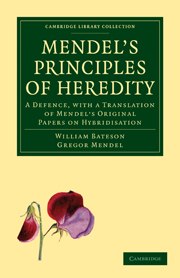 Mendel's Principles of Heredity
Mendel's Principles of Heredity MENDEL'S EXPERIMENTS WITH HIERACIUM
Published online by Cambridge University Press: 07 September 2010
Summary
Although I have already undertaken many experiments in fertilisation between species of Hieracium, I have only succeeded in obtaining the following 6 hybrids, and only from one to three specimens of them.
H. Auricula ♀ × H. aurantiacum ♂
H. Auricula ♀ × H. Pilosella ♂
H. Auricula ♀ × H. pratense ♂
H. echioides ♀ × H. aurantiacum ♂
H. prœaltum ♀ × H. flagellare Rchb. ♂
H. prœaltum ♀ × H. aurantiacum ♂
The difficulty of obtaining a larger number of hybrids is due to the minuteness of the flowers and their peculiar structure. On account of this circumstance it was seldom possible to remove the anthers from the flowers chosen for fertilisation without either letting pollen get on to the stigma or injuring the pistil so that it withered away. As is well known, the anthers are united to form a tube, which closely embraces the pistil. As soon as the flower opens, the stigma, already covered with pollen, protrudes. In order to prevent self-fertilisation the anther-tube must be taken out before the flower opens, and for this purpose the bud must be slit up with a fine needle. If this operation is attempted at a time when the pollen is mature, which is the case two or three days before the flower opens, it is seldom possible to prevent self-fertilisation; for with every care it is not easily possible to prevent a few pollen grains getting scattered and communicated to the stigma.
- Type
- Chapter
- Information
- Mendel's Principles of HeredityA Defence, with a Translation of Mendel's Original Papers on Hybridisation, pp. 96 - 103Publisher: Cambridge University PressPrint publication year: 2009
